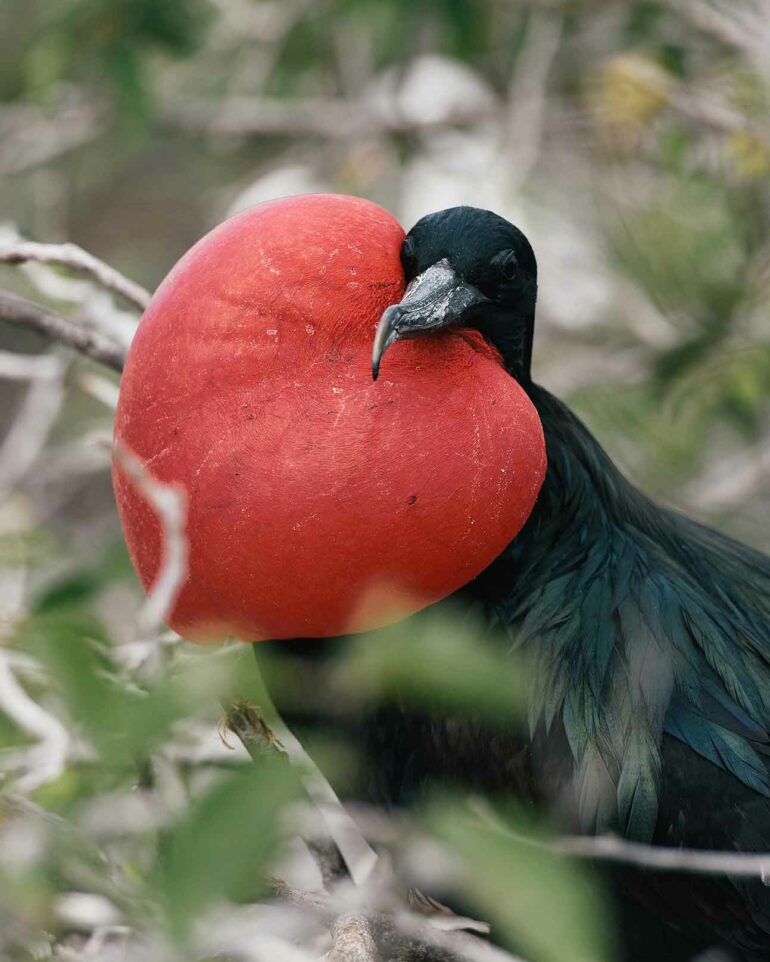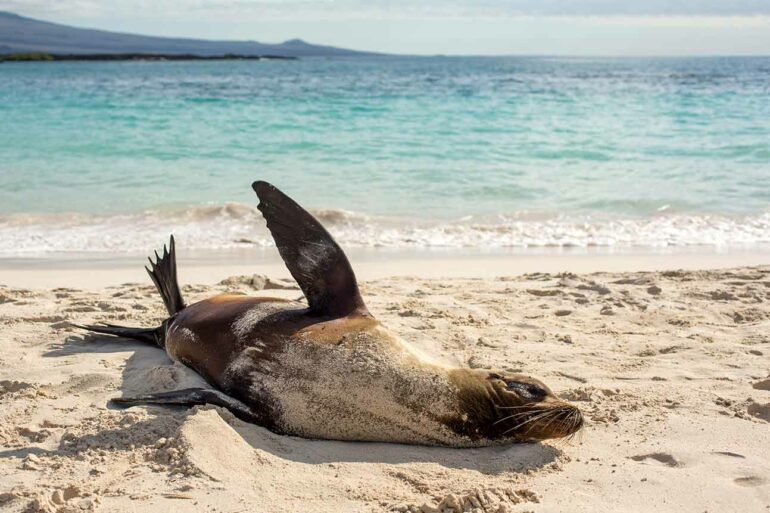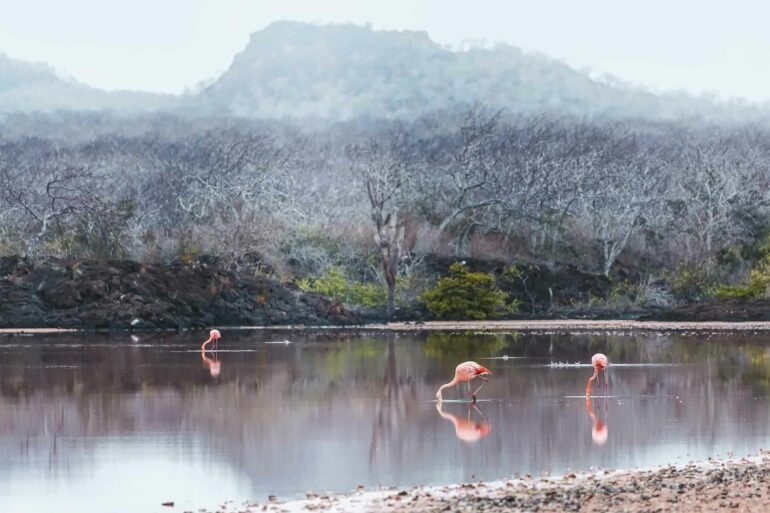For sightings of some of the most unusual wildlife on earth, a cruise around the Galápagos is a no-brainer. But for self-evolution? Uwern Jong hadn’t bargained on that.
It’s a glorious March day and the midday sun is beating down hard on the top deck of Ecoventura’s luxury expedition yacht Theory as we drop anchor in the bay just off Bartolomé Island. The weather here is characteristically balmy, especially at this time of year, I’m told, as we approach the spring equinox and the sun is directly above the equator. The clear sky seems somehow more infinite than it has over the past week I’ve been off land, our yacht just a small, bright, bobbing speck in the equally endless, mirror-like sea, divided from the sky only by the horizon and the breathtaking view of this island’s famous landmark Pinnacle Rock. This is picture-postcard Galápagos Islands: moody, rugged and raw in the shadows of its volcanic geology and glistening with hues of orange and green in the bright, equatorial sunshine.
I fancy myself as an intrepid explorer at large in Ecuador, a modern-day Charles Darwin, fresh off the boat – or rather on it. Except that Darwin didn’t have it this good when he first came here on the HMS Beagle nearly 200 years ago. As Galápagos expedition yachts go, Theory and the other members of the specialist Ecoventura fleet define luxury of the indulgent variety, especially when the water is this calm – the water in the Jacuzzi I’m lying in at the ship’s bow, that is.
Overhead, frigatebirds circle like pterodactyls, probably wondering what the bubbling human soup beneath them tastes like. Or perhaps they, too, fancy a warm soak. They get a little less interested when more humans appear on deck, but they don’t leave. They’re not afraid of us. That’s the beauty of wildlife here in the archipelago – they understand coexistence. I follow them in this life lesson as I crack a smile for my fellow passengers, who have now crowded around the hot tub to snap a picture of the island, destined no doubt for social media. I don’t blame them – between the scenery and this amazing yacht, there’s plenty to brag about to those at home.

This story first appeared in The Next Chapter Issue, available in print and digital.
Subscribe today or purchase a back copy via our online shop.
I use the word ‘crowded’ loosely. On board are just 17 other explorers. My new friends. Like the Galápagos sea lions playing what looks like tag in the water and the penguins swept here from Antarctica by the Humboldt Current and now basking on a rock, my fellow adventurers and I are a collection of different ‘species’, from a variety of backgrounds all over the world. That’s the wonderful thing about small-ship cruising – beyond the unique and enriching experience of the expedition itself, sharing the wonders of the journey also offers an opportunity to get to know one another. A week ago we boarded as strangers. Now, it seems, we shall leave as forever friends.
Some of the party started their Ecuadorean journey like me, discovering the capital Quito, others by mooching around Guayaquil. Both cities are gateways to the wonderland that is the Galápagos. Eventually, we all made our way to sleepy San Cristóbal (aptly named after the patron saint of travellers) and, once on board our yacht, we meet our guides – Ceci, an effervescent Dora the Explorer-like character, and Billy, a huggable bear of a man.
Guides make or break a live-aboard journey. They’re with you all week, so they effectively have to be able to play both friend and host, as well as having an encyclopedic knowledge and being effortlessly entertaining. It’s also them you have to trust with your safety when you’re out on an expedition. No problem here, of course, as both are first-class, handpicked by Ecoventura as among the best at what they do. As the week progresses, it’s plain to see that they are both consummate guides who can also turn their hand to some fervent guitar strumming and belt out a hearty version of ‘Guantanamera’ to thrill and charm the troops or of ‘Iguana, ooh na-na’ to the tune of Camila Cabello’s ‘Havana’, which turns out to be the ear-worm of the trip.
“Only three percent of flora and fauna have diminished since the park opened back in the 1960s, a refreshing change from other ecological sites on the planet.”
We’re not going to straddle the equator on this journey. Unlike Ecoventura’s western and northern route, its southern and central itinerary means we never ‘cross the line’. Instead, the whole trip is designed to maximise the wildlife-spotting opportunities.
Sustainability is at the very heart of everything here on the expedition and I’m encouraged to hear that, despite tourism, only three percent of flora and fauna have diminished since the Galápagos National Park opened back in the 1960s, a refreshing change from what is happening on many other ecological sites on our planet. A lot of that is the result of the way tourism is managed here. Each expedition has strictly planned itineraries and only five groups of up to 16 people are allowed ashore on any island at one time. Yet, the danger of over-tourism remains a risk.
Ecoventura also plays its part. It’s held a Smart Voyager certification for over two decades. In fact, it was the first recipient of this voluntary ecological accreditation established by the Rainforest Alliance. More recently, the company’s vessels have partnered with the Charles Darwin Foundation and the Galápagos National Park Service to establish the Galápagos Biodiversity and Education for Sustainability Fund, which develops programmes that support projects related to biodiversity conservation, as well as providing education for the next generation of Galápagan biologists.
At the start of each day, I don my wetsuit and board a panga or Zodiac boat for an enthralling excursion. Circling Cerro Brujo (otherwise known as Witch’s Hill), I’m enchanted by the sheer volume of birdlife, an entire community of pelicans, terns and Nazcar boobies. Fluorescent Sally Lightfoot crabs scurry over the craggy volcanic rock, some rising up to create almost mystical geological formations. I jump off on to the smooth white-sand beach. All around me are marine iguanas (‘ooh na-na’) lazing in the sun. Huge sea lions are doing the same, albeit less discreetly, rolling around in the sand and barking a warm welcome as we wade ankle-deep in the shimmering, platinum sea.
I take a searing hike on Punta Pitt in search of the storied blue-footed booby. I find many, nesting peacefully. They stand as I approach, unashamedly lifting their feathered skirts like a burlesque dancer, tantalisingly showing their bright-blue feet. The conquistadors considered them clownish and clumsy (the name booby comes from the Spanish word ‘bobo’, meaning foolish or stupid), but they’re expert aerialists and swimmers, which goes a long way to demonstrate how being different can be amazing.
Landing on the island of Española, we look for the waved albatross, but sadly there aren’t many here yet at this time of year. They’re more likely to come to court between April and December, spending what seems like eons out on the open ocean. The marine iguanas here are different from the ones before. With algae as their diet, they’re bright red and green. Walking across the craggy landscape to a dramatic blowhole, I spot hundreds of different birds along the way – doves, finches, tropicbirds, mockingbirds, hawks and gulls. At Gardner Bay, on one of the most elegant beaches I’ve ever laid eyes on, I sift the cool white sand through my bare toes. That night, the stars come out to play, lighting up the night sky, just as the birds did during the day.
















